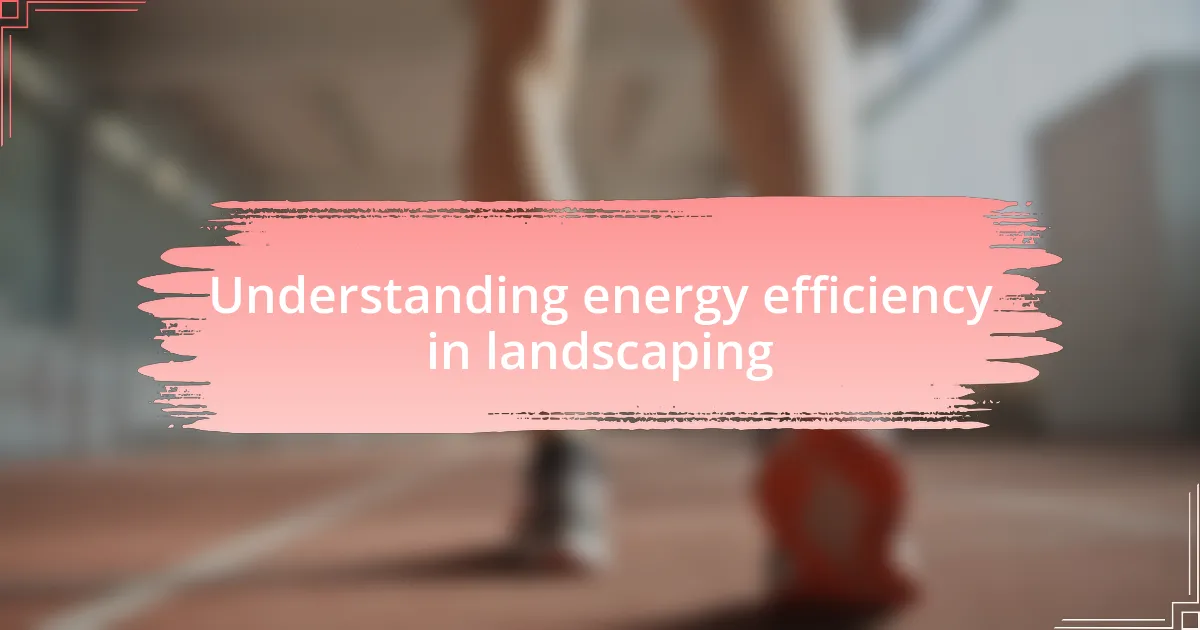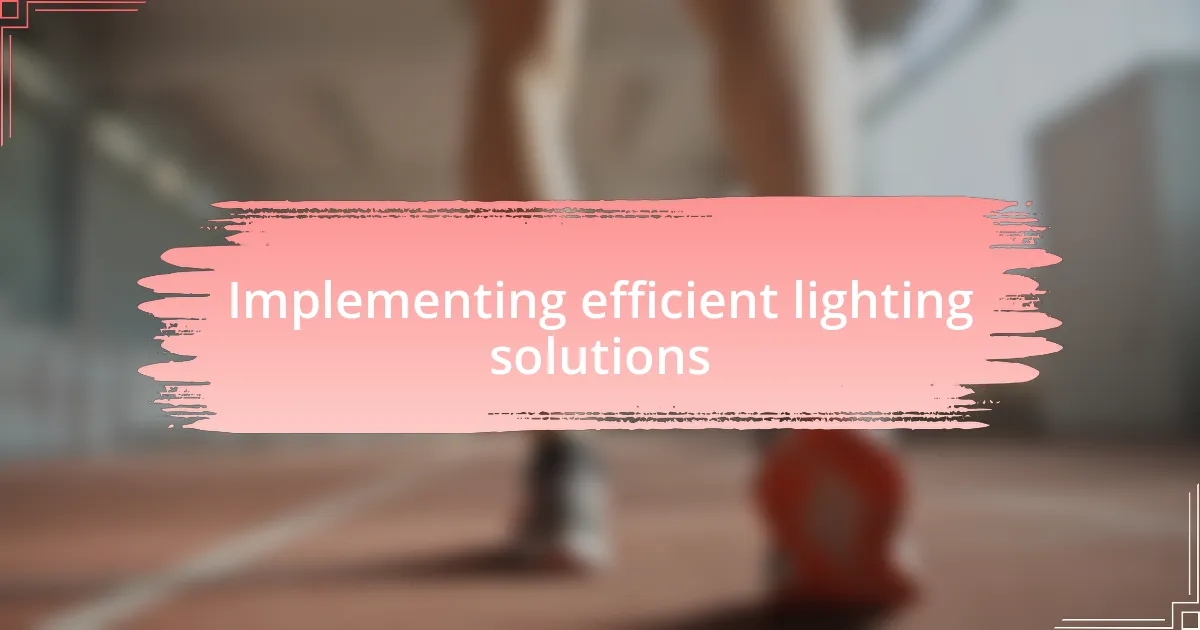Key takeaways:
- Strategically placed trees and native plants enhance energy efficiency by reducing cooling costs and water usage.
- Incorporating water features and sustainable materials improves outdoor aesthetics and supports environmental goals.
- Using rain barrels, xeriscaping, and drip irrigation maximizes water conservation and fosters healthier landscapes.
- Efficient lighting solutions, such as LED and solar-powered lights, reduce energy costs while enhancing outdoor enjoyment.

Understanding energy efficiency in landscaping
When I first got into landscaping, I didn’t realize just how much energy efficiency could transform a space. Plants are more than just aesthetic elements; they play a significant role in managing heat and improving energy consumption. For instance, strategically placed trees can provide shade, reducing the need for air conditioning in warmer months. Have you ever thought about how much you spend on cooling?
In my experience, native plants are a game-changer. They require less water and maintenance, which not only saves energy but also contributes to a more sustainable ecosystem. I remember planting drought-resistant species in my garden, and not only did they thrive with minimal water, but they also attracted local wildlife, enhancing the area’s natural balance. It’s heartening to see how small choices can lead to significant energy savings.
Understanding energy efficiency in landscaping means embracing techniques that align our outdoor spaces with environmental goals. Have you considered the impact of hardscaping on energy bills? Choosing permeable materials can reduce runoff and improve groundwater recharge, ultimately supporting healthier landscapes. I’ve found that integrating these elements into my designs not only benefits the environment but also creates a more enjoyable outdoor experience.

Designing energy efficient outdoor spaces
When I approach designing outdoor spaces, I always start with the sun’s path. Positioning seating areas or outdoor living spaces to capture natural light can drastically cut down on artificial lighting needs. I recall a project I took on where I oriented the deck facing the setting sun, and it became a favorite spot for evening gatherings, all while reducing electricity costs.
Water features can be both beautiful and practical in energy-efficient designs. I’ve seen how incorporating a small pond or fountain can naturally cool the surrounding area, creating a more pleasant environment without cranking up the air conditioning. It’s fascinating to see how the gentle sound of water can transform a space into a serene retreat, all while supporting energy efficiency.
Another element that stands out in my designs is the thoughtful inclusion of pathways. The choice of sustainable materials, like reclaimed wood or local stone, not only enhances the aesthetic appeal but also minimizes energy use during production. I remember walking through a garden with gravel paths that allowed rainwater to seep through, nourishing the plants while reducing runoff. It’s a beautiful example of how landscaping can harmoniously blend function with environmental responsibility.

Utilizing water conservation techniques
One simple yet effective technique I’ve embraced is the use of rain barrels. I vividly remember when I installed one in my backyard; it collected water from the roof during a rainfall. Not only did it provide a sustainable source for watering my garden, but it also taught me the value of resourcefulness. Have you ever thought about how much water we can save by reusing what nature gives us?
Another strategy I find beneficial is xeriscaping, which involves using drought-resistant plants native to the area. I once transitioned a thirsty lawn into a vibrant landscape filled with colorful succulents and ornamental grasses. Watching the garden flourish while requiring minimal water was incredibly satisfying. Isn’t it amazing how nature has plants that thrive on less water, helping us cut back and conserve?
Moreover, implementing drip irrigation systems has been a game-changer for me. I recall setting one up for a community garden, and the results were impressive. The precise delivery of water directly to the roots not only saved water but also improved the health of the plants. It’s so gratifying to see how these small changes can make a significant impact on both our gardens and the environment.

Implementing efficient lighting solutions
Implementing efficient lighting solutions has transformed my outdoor spaces in ways I hadn’t imagined. One memorable project was switching to LED garden lights. The first night after installation, I stepped outside and was greeted by a warm, inviting glow that highlighted my plants beautifully while using a fraction of the energy my old lights consumed. Isn’t it remarkable how something as simple as a light bulb can make such a difference?
I’ve also experimented with solar-powered lights, which have truly changed my approach to landscaping. While setting up a series of pathway lights, I felt a sense of excitement knowing they harness energy from the sun. Not only do they illuminate my walkways, but they’ve also taken away the anxiety of rising electricity bills. Have you ever experienced that thrill of knowing you’re making an environmentally friendly choice while enhancing your property’s aesthetics?
Finally, I can’t emphasize enough the impact of strategically placed lighting. I once designed a small seating area in my backyard and decided to position soft lighting along the edges. The transformation was instant—a cozy ambiance enveloped the space, inviting friends to gather for evening conversations. I often reflect on how effective lighting not only enhances beauty but also creates warmth and connection. Isn’t it wonderful how well-planned illumination can reshape our enjoyment of outdoor environments?

My personal landscaping enhancement tips
One of my favorite landscaping enhancement tips is incorporating native plants into my garden. When I started choosing flora that naturally thrives in my region, I noticed a remarkable transformation. The reduced need for water and maintenance not only saved me time but also created a vibrant ecosystem that buzzed with life. Have you ever experienced the joy of watching butterflies flutter around your garden? It really solidifies the idea that working with nature can yield beautiful results.
Another impactful change I’ve made is adding rain barrels to my landscape. Initially, I was skeptical about how much water I could actually collect. However, after just a few rainy days, I was amazed to see how much I was saving! It felt empowering to know that I was using what nature provided, reducing my water bill, and nurturing my plants with fresh rainwater. Isn’t it satisfying to find practical ways to enhance both your garden and your budget?
Finally, I’ve learned the value of creating outdoor zones that encourage energy efficiency through design. I once set up a cozy nook surrounded by foliage and shade trees, and it has become my go-to spot to relax during hot summer days. This not only lowered my reliance on air conditioning but also deepened my appreciation for natural airflow and shade. Have you thought about how reorganizing your outdoor spaces could help you enjoy them more while keeping energy costs down? It’s truly a rewarding project that brings comfort while being environmentally mindful.